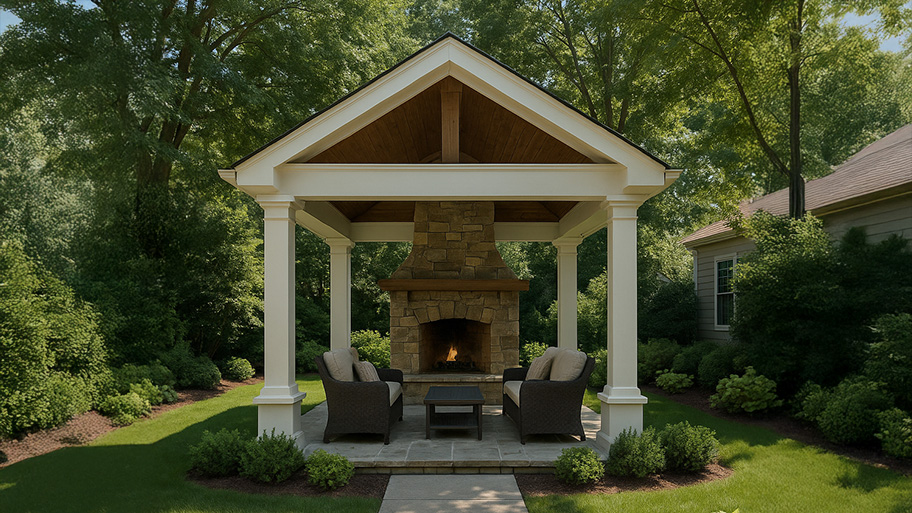
From patios and gazebos to full-on structures, your outdoor space is a blank slate. Learn how much it costs to build and furnish an outdoor room.
Even outdoor kitchens deserve a flooring glow up


Nothing beats a full-fledged outdoor kitchen for deckside breakfasts and gourmet get-togethers. However, just because the kitchen is outside doesn’t mean the floor should be simple dirt. There’s a diverse array of kitchen flooring options appropriate for outdoor use, each with its own benefits and preferred use-case scenarios. Here are the best flooring types for outside kitchens to bring your outdoor dinner parties to the next level.

Looking for a budget-friendly, versatile, and durable flooring option? Look no further than concrete. This bare-bones material costs $3 to $8 per square foot, depending on the design and type of concrete used. Concrete is easily shaped and molded into a vast array of shapes and designs, though you may have to paint to match your preferred aesthetic. A major downside of concrete is that it requires significant maintenance, as it cracks over time. Paying for regular maintenance can be a drag, particularly as building an outdoor kitchen costs $6,000 to $25,000. Still, concrete is more than durable enough to handle heavy appliances.

This is by far the most budget-friendly option, at $1 to $4 per square foot, but comes with some drawbacks. Gravel is difficult to clean, hard to tamp down, and may not provide a stable surface for heavy kitchen appliances. You’ll also get weed growth over time and affiliated pests. Finally, gravel isn’t exactly an aesthetic powerhouse, which is not fun if you just mastered the art of DIY outdoor kitchen cabinets. Beyond cost, there are some other positives when choosing gravel. It’s comfortable to walk on, which is a bonus when standing over a hot grill. Gravel is also simple to install and helps with drainage.

Tile isn’t a material, but rather a flooring type made from a variety of different materials, giving you increased options regarding color, shape, size, and overall aesthetics. The tiles themselves are placed however you see fit, allowing for a highly personalized outdoor kitchen design. Not every tile material is appropriate for an outdoor kitchen, as the flooring has to support the weight of various appliances. Stone tiles are a fantastic option, costing $3 to $35 per square foot. Permeable pavers are another good idea, as they are eco-friendly, though they cost $10 to $30 per square foot. Ceramic tiles costs $4 to $10 per square foot, but could struggle under the weight of your appliances. Talk to a pro to discuss the durability of your preferred tile material.

There’s a reason decking materials are popular when building outdoor hotspots. Decking is constructed using natural wood or composite materials, and both easily withstand the weight of an outdoor kitchen. Wood offers unparalleled aesthetics, but runs into serious maintenance issues like rot over time. Composite decking isn’t quite as easy on the eyes, but requires limited maintenance. All told, installing this type of flooring costs $30 to $60 per square foot, depending on the type of wood you go with or the type of composite material.

Brick pavers are no slouch when it comes to outdoor flooring. This material is relatively budget-friendly, at $8 to $25 per square foot, and boasts an endlessly appealing retro look. Bricks are also durable, so you should have no trouble placing heavy appliances. Brick pavers are non-slip, making them a great choice for rain-soaked locations. Brick requires a fair level of maintenance, however, to avoid stains. Make sure to seal it every couple of years and keep up with general cleaning to avoid mold and mildew. Also, brick pavers are not the most comfortable material to stand on for long periods of time, leading to unhappy grill masters.

Despite the popular image of a fragile porcelain doll, this material is actually quite durable, as it’s clay-fired at extremely high temperatures. In other words, feel free to rest heavy appliances all over your porcelain floor. This material is relatively easy to install, though difficult to cut to shape. Porcelain is mold-resistant, great for all weather scenarios, easy to clean, and requires little maintenance. So what’s the downside? Porcelain isn’t especially budget-friendly, at $10 to $30 per square foot installed.

Wait, rubber? Yes, rubber. This might not be the first material you think of when looking at outdoor flooring options, but it’s actually a decent choice. Rubber is durable, available in multiple design options, and particularly DIY-friendly to install. This type of flooring is installed in pieces, so if one gets damaged, just swap it out. It costs around $10 per square foot, which is more than some outdoor flooring types like concrete and gravel, but there are virtually no maintenance costs. Rubber is also slip-resistant, water-resistant, and heat-resistant. This is rubber, however, so don’t expect a natural aesthetic.
From average costs to expert advice, get all the answers you need to get your job done.

From patios and gazebos to full-on structures, your outdoor space is a blank slate. Learn how much it costs to build and furnish an outdoor room.

A deck skirt can improve the form and function of a deck. Find out what it could cost to install deck skirting in your backyard with this guide.

The average gazebo installation cost depends on the size and material. Keep reading to discover how much your gazebo may cost.

Consider these awning questions when installing or replacing a metal awning or patio cover. The answers can determine who you hire and how long the project takes.

Enjoy your backyard—without some of the pesky elements that come with outdoor living. Check out some gazebo ideas to give your outdoor living space an upgrade.

Concrete is ideal for an outdoor patio, walkway, or steps. Here are the questions to ask a contractor about your next concrete installation project.